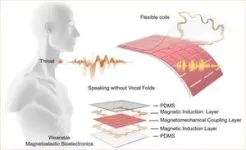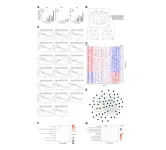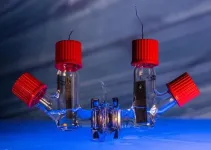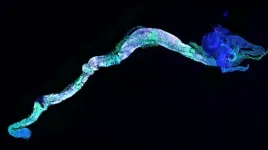(Press-News.org) BIRMINGHAM, Ala. – Hunger can drive a motivational state that leads an animal to a successful pursuit of a goal — foraging for and finding food.
In a highly novel study published in Current Biology, researchers at the University of Alabama at Birmingham and the National Institute of Mental Health, or NIMH, describe how two major neuronal subpopulations in a part of the brain’s thalamus called the paraventricular nucleus participate in the dynamic regulation of goal pursuits. This research provides insight into the mechanisms by which the brain tracks motivational states to shape instrumental actions.
For the study, mice first had to be trained in a foraging-like behavior, using a long, hallway-like enclosure that had a trigger zone at one end and a reward zone at the other end, more than 4 feet distant.
Mice learned to wait in a trigger zone for two seconds, until a beep triggered initiation of their foraging-like behavioral task. A mouse could then move forward at its own pace to the reward zone to receive a small gulp of strawberry-flavored Ensure. To terminate the trial, the mice needed to leave the reward zone and return to the trigger area, to wait for another beep. Mice learned quickly and were highly engaged, as shown by completing a large volume of trials during training.
The researchers then used optical photometry and the calcium sensor GCaMP to continuously monitor activity of two major neuronal subpopulations of the paraventricular nucleus, or PVT, during the reward approach from the trigger zone to the reward zone, and during the trial termination from the reward zone back to the trigger zone after a taste of strawberry-flavored food. The experiments involve inserting an optical fiber into the brain just about the PVT to measure calcium release, a signal of neural activity.
The two subpopulations in the paraventricular nucleus are identified by presence or absence of the dopamine D2 receptor, noted as either PVTD2(+) or PVTD2(–), respectively. Dopamine is a neurotransmitter that allows neurons to communicate with each other.
“We discovered that PVTD2(+) and PVTD2(–) neurons encode the execution and termination of goal-oriented actions, respectively,” said Sofia Beas, Ph.D., assistant professor in the UAB Department of Neurobiology and a co-corresponding author of the study. “Furthermore, activity in the PVTD2(+) neuronal population mirrored motivation parameters such as vigor and satiety.”
Specifically, the PVTD2(+) neurons showed increased activity during the reward approach and decreased activity during trial termination. Conversely, PVTD2(–) neurons showed decreased activity during the reward approach and increased activity during trial termination.
“This is novel because people didn’t know there was diversity within the PVT neurons,” Beas said. “Contrary to decades of belief that the PVT is homogeneous, we found that, even though they are the same types of cells (both release the same neurotransmitter, glutamate), PVTD2(+) and PVTD2(–) neurons are doing very different jobs. Additionally, the findings from our study are highly significant as they help interpret contradictory and confusing findings in the literature regarding PVT’s function.”
For a long time, the thalamic areas such as the PVT had been considered just a relay station in the brain. Researchers now realize, Beas says, that the PVT instead processes information, translating hypothalamic-derived needs states into motivational signals via projections of axons — including the PVTD2(+) and PVTD2(–) axons — to the nucleus accumbens, or NAc. The NAc has a critical role in the learning and execution of goal-oriented behaviors. An axon is a long cable-like extension from a neuron cell body that transfers the neuron’s signal to another neuron.
Researchers showed that these changes in neuron activity at the PVT were transmitted to the NAc by measuring neural activity with an optical fiber inserted where the terminals of the PVT axons reach the NAc neurons. The activity dynamics at the PVT-NAc terminals largely mirrored the activity dynamics the researchers saw at the PVT neurons — namely increased neuron activity signal of PVTD2(+) during reward approach and increased neuron activity of PVTD2(–) during trial termination.
“Collectively, our findings strongly suggest that motivation-related features and the encoding of goal-oriented actions of posterior PVTD2(+) and PVTD2(-) neurons are being relayed to the NAc through their respective terminals,” Beas said.
During each mouse recording session, the researchers recorded eight to 10 data samples per second, resulting in a very big dataset. In addition, these types of recordings are subject to many potential confounding variables. As such, the analysis of this data was another novel aspect of this study, through use of a new and robust statistical framework based on Functional Linear Mixed Modeling that both account for the variability of the recordings and can explore the relationships between the changes of photometry signals over time and various co-variates of the reward task, such as how quickly mice performed a trial, or how the hunger levels of the animals can influence the signal.
One example of how researchers correlated motivation with task performance was separating the trial times into “fast” groups, two to three seconds to the reward zone from the trigger zone, and “slow” groups, nine to 11 seconds to the reward zone.
“Our analyses showed that reward approach was associated with higher calcium signal ramps in PVTD2(+) neurons during fast compared to slow trials,” Beas said. “Moreover, we found a correlation between signal and both latency and velocity parameters. Importantly, no changes in posterior PVTD2(+) neuron activity were observed when mice were not engaged in the task, as in the cases where mice were roaming around the enclosure but not actively performing trials. Altogether, our findings suggest that posterior PVTD2(+) neuron activity increases during reward-seeking and is shaped by motivation.”
Deficits in motivation are associated with psychiatric conditions like substance abuse, binge eating and the inability to feel pleasure in depression. A deeper understanding of the neural basis of motivated behavior may reveal specific neuronal pathways involved in motivation and how they interact. This could lead to new therapeutic targets to restore healthy motivational processes in patients.
Co-authors with Beas in the study, “Dissociable encoding of motivated behavior by parallel thalamo-striatal projections,” are Isbah Khan, Claire Gao, Gabriel Loewinger, Emma Macdonald, Alison Bashford, Shakira Rodriguez-Gonzalez, Francisco Pereira and Mario Penzo, NIMH, Bethesda, Maryland. Beas was a post-doctoral fellow at the NIMH before moving to UAB last year.
Support came from National Institutes of Health award K99/R00 MH126429, a NARSAD Young Investigator Award by the Brain and Behavior Research Foundation, and NIMH Intramural Research Program award 1ZIAMH002950.
At UAB, Neurobiology is a department in the Marnix E. Heersink School of Medicine.
END
How the brain translates motivation into goal-oriented behavior, according to new study
: In the mouse brain, two neural pathways were discovered: The first is active during motivation; the second is active only at the termination of motivation. In humans, these pathways could underlie motivational dysfunctions present in various psychiatric
2024-03-15
ELSE PRESS RELEASES FROM THIS DATE:
Genome-wide transcriptome profiling and development of age prediction models in the human brain
2024-03-15
“Our approach identified genes that were previously implicated in aging, as well as new ones that may warrant further investigation.”
BUFFALO, NY- March 15, 2024 – A new research paper was published on the cover of Aging (listed by MEDLINE/PubMed as "Aging (Albany NY)" and "Aging-US" by Web of Science) Volume 16, Issue 5, entitled, “Genome-wide transcriptome profiling and development of age prediction models in the human brain.”
Aging-related transcriptome changes in various regions of the healthy human brain have been explored in previous works, however, a study to develop prediction models for age based on the expression levels of specific ...
Speaking without vocal cords, thanks to a new AI-assisted wearable device
2024-03-15
People with voice disorders, including those with pathological vocal cord conditions or who are recovering from laryngeal cancer surgeries, can often find it difficult or impossible to speak. That may soon change.
A team of UCLA engineers has invented a soft, thin, stretchy device measuring just over 1 square inch that can be attached to the skin outside the throat to help people with dysfunctional vocal cords regain their voice function. Their advance is detailed this week in the journal Nature Communications.
The new bioelectric system, developed ...
Rice breakthrough could make automated dosing systems universal
2024-03-15
by Jade Boyd
Special to Rice News
HOUSTON – (March 15, 2024) – Rice University synthetic biologists have found a way to piggyback on the glucose monitoring technology used in automated insulin dosing systems and make it universally applicable for the monitoring and dosing of virtually any drug.
In a recently published study in Nature Communications, researchers in the lab of Caroline Ajo-Franklin demonstrated the technique by modifying a blood-glucose sensor to detect the anticancer drug afimoxifene ...
UTA students earn transformative D.C. fellowships
2024-03-15
Seven undergraduate students from The University of Texas at Arlington headed to Washington, D.C., for a hands-on program to live, learn and intern in the nation’s capital.
Founded in 2001, The Archer Center is the Washington, D.C., campus of the University of Texas System. Students accepted to its Archer Fellowship Program move to the Capitol Hill area of Washington to live with other Archer Fellows and take courses taught by UT faculty and policy experts. The scholars also participate in a ...
Why some newborns develop severe infections
2024-03-15
NEW YORK, NY (March 15, 2024)--Compared to adults, newborns are highly susceptible to infections and these infections can cause serious health complications and even death.
One factor known to affect a newborn’s response to infection is a condition called neonatal neutropenia, in which the infant fails to make enough neutrophils, the immune system’s first responders. What underlies this immune deficiency, which greatly increases a newborn’s susceptibility to infection, is largely unknown, leaving clinicians with little understanding of how to prevent or treat it.
A new study of mice by Columbia University ...
Protein fragments ID two new “extremophile” microbes—and may help find alien life
2024-03-15
Perfectly adapted microorganisms live in extreme environments from deep-sea trenches to mountaintops. Learning more about how these extremophiles survive in hostile conditions could inform scientists about life on Earth and potential life on other planets. In ACS’ Journal of Proteome Research, researchers detail a method for more accurate extremophile identification based on protein fragments instead of genetic material. The study identified two new hardy bacteria from high-altitude lakes in Chile — an ...
Plasma oscillations propel breakthroughs in fusion energy
2024-03-15
Most people know about solids, liquids, and gases as the main three states of matter, but a fourth state of matter exists as well. Plasma—also known as ionized gas—is the most abundant, observable form of matter in our universe, found in the sun and other celestial bodies.
Creating the hot mix of freely moving electrons and ions that compose a plasma often requires extreme pressures or temperatures. In these extreme conditions, researchers continue to uncover the unexpected ways that plasma can move and evolve. By better understanding the motion of plasma, scientists gain valuable insights into solar physics, astrophysics, ...
Specialized nursing facility clinicians improve end-of-life care
2024-03-15
Specialized nursing facility clinicians, or SNFists, may decrease the likelihood of nursing home residents experiencing stressful hospitalizations and improve the quality of life in their last days, according to researchers from Weill Cornell Medicine.
The paper, published in JAMA Network Open on Mar. 15, examined how SNFists uniquely impacted the care of nursing home residents in their last 90 days, compared with those cared for by other clinicians. This large-scale study is the first of its kind.
“The literature has described ...
Fatty food before surgery may impair memory in old, young adults
2024-03-15
COLUMBUS, Ohio – Eating fatty food in the days leading up to surgery may prompt a heightened inflammatory response in the brain that interferes for weeks with memory-related cognitive function in older adults – and, new research in animals suggests, even in young adults.
The study, building upon previous research from the same lab at The Ohio State University, also showed that taking a DHA omega-3 fatty acid supplement for a month before the unhealthy eating and surgical procedure prevented the effects on memory linked to both the high-fat diet and the surgery in aged ...
Newly discovered receptor influences gut development in fruit flies
2024-03-15
Adhesion GPCRs belong to the large family of G protein-coupled receptors (GPCRs). There are about 700 variants in humans, which are responsible for sensory impressions, hormonal cycles, controlling the cardiovascular system and more. GPCRs translate stimuli that hit a cell from outside into an intracellular biochemical signal.
The use of the fruit fly as a model animal allows researchers in this field to gain a deep understanding of human diseases, because the animals are genetically very similar to humans. Scientists estimate that around 75 per cent of the genes involved in human diseases ...
LAST 30 PRESS RELEASES:
Researchers use robotics to find potential new antibiotic among hundreds of metal complexes
Gut bacteria changes at the earliest stages of inflammatory bowel disease
Scientists develop new way to “listen in” on the brain’s hidden language
Brain research: “Pulse generators” grow and shrink as memories are formed
For teens, any cannabis use may have impact on emotional health, academic performance
School meals could unlock major gains for human and planetary health
Menopause hormone therapy does not appear to impact dementia risk
Signature patterns of brain activity may help predict recovery from traumatic brain injury
Dresden study uncovers new key mechanism in cancer cells
New species are now being discovered faster than ever before, study suggests
Cannabis-based products show limited short-term benefit for chronic pain, with increased risk of adverse effects
Cannabis products with more THC slightly reduce pain but cause more side effects
Clearing the brain of aging cells could aid epilepsy and reduce seizures
Brain injuries linked with potential risk of suicide, new study finds
New technique lights up where drugs go in the body, cell by cell
New study finds movement of fishing fleets can reveal shifts in marine ecosystems
Embargoed: New evidence points to potential treatment for vascular dementia
Study uncovers disrupted brain balance in alcohol dependence
Working in groups can help Republicans and Democrats agree on controversial content moderation online
Structural findings reveal how distinct GPCR ligands create different levels of activation
Anything-goes “anyons” may be at the root of surprising quantum experiments
UC review: Maximizing workplace opportunity for veterans
From generation to complex control: Metasurfaces make perfect vortex beams "within reach"
Thin-film lithium niobate-based detector: recent advances and perspectives
Exploring why some people may tend to persistently make bad choices
How cells balance their protein levels
Nirsevimab vs RSVpreF vaccine for RSV–related hospitalization in newborns
Effectiveness and impact of maternal RSV immunization and nirsevimab on medically attended RSV in US children
AI gives scientists a boost, but at the cost of too many mediocre papers
Next-generation vision model maps tree growth at sub-meter precision
[Press-News.org] How the brain translates motivation into goal-oriented behavior, according to new study: In the mouse brain, two neural pathways were discovered: The first is active during motivation; the second is active only at the termination of motivation. In humans, these pathways could underlie motivational dysfunctions present in various psychiatric








